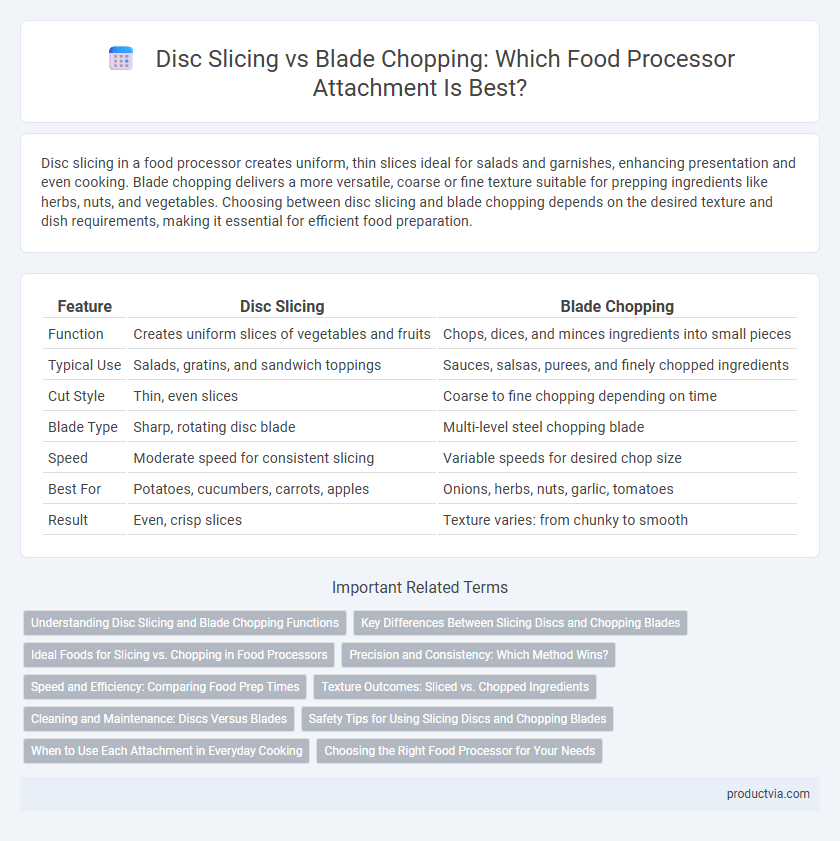Disc slicing in a food processor creates uniform, thin slices ideal for salads and garnishes, enhancing presentation and even cooking. Blade chopping delivers a more versatile, coarse or fine texture suitable for prepping ingredients like herbs, nuts, and vegetables. Choosing between disc slicing and blade chopping depends on the desired texture and dish requirements, making it essential for efficient food preparation.
Table of Comparison
| Feature | Disc Slicing | Blade Chopping |
|---|---|---|
| Function | Creates uniform slices of vegetables and fruits | Chops, dices, and minces ingredients into small pieces |
| Typical Use | Salads, gratins, and sandwich toppings | Sauces, salsas, purees, and finely chopped ingredients |
| Cut Style | Thin, even slices | Coarse to fine chopping depending on time |
| Blade Type | Sharp, rotating disc blade | Multi-level steel chopping blade |
| Speed | Moderate speed for consistent slicing | Variable speeds for desired chop size |
| Best For | Potatoes, cucumbers, carrots, apples | Onions, herbs, nuts, garlic, tomatoes |
| Result | Even, crisp slices | Texture varies: from chunky to smooth |
Understanding Disc Slicing and Blade Chopping Functions
Disc slicing in a food processor uses a flat, rotating disc with a sharp edge to create uniform, thin slices of vegetables, fruits, or cheese, ideal for salads and gratins. Blade chopping employs a multi-pronged, spinning blade that finely chops, dices, or purees ingredients, perfect for preparing sauces, salsas, and doughs. Understanding these functions helps optimize food preparation by selecting the appropriate attachment for texture and consistency.
Key Differences Between Slicing Discs and Chopping Blades
Slicing discs in food processors create uniform, thin slices ideal for vegetables and fruits, while chopping blades deliver a rougher, chopped texture suitable for nuts, herbs, and tougher ingredients. The disc rotates parallel to the bowl, enabling consistent thickness, whereas the S-shaped chopping blade spins horizontally, producing varied cuts through rapid, multi-directional chopping. Understanding these functional differences helps optimize food preparation techniques, ensuring precision and efficiency in meal assembly.
Ideal Foods for Slicing vs. Chopping in Food Processors
Disc slicing in food processors excels at creating uniform, thin slices of vegetables like cucumbers, carrots, and potatoes, ideal for salads or gratins. Blade chopping is perfect for dicing and mincing softer foods such as onions, garlic, herbs, and cooked meats, offering versatility for sauces and fillings. Choosing the right attachment enhances texture precision and efficiency, tailoring food preparation to specific recipes.
Precision and Consistency: Which Method Wins?
Disc slicing in food processors delivers superior precision and consistent thickness, ideal for uniform vegetable slices and professional plating. Blade chopping offers variable texture and coarser cuts, making it versatile for rough chopping or mincing but less consistent in size. For tasks demanding exactness and evenness, disc slicing outperforms blade chopping in precision and consistency.
Speed and Efficiency: Comparing Food Prep Times
Disc slicing in food processors offers faster preparation times for uniform slices, ideal for vegetables and fruits, while blade chopping excels at quickly processing a variety of ingredients into coarse or fine pieces. Slicing discs provide consistent thickness and reduce manual effort, increasing overall kitchen efficiency during meal prep. Blade chopping delivers versatile cutting speeds that handle tougher textures but may require additional processing time for evenly sized results.
Texture Outcomes: Sliced vs. Chopped Ingredients
Disc slicing in a food processor produces uniform, thin slices ideal for salads, gratins, and garnishes, preserving the integrity and appearance of ingredients. Blade chopping results in varied, coarse to fine textures suitable for salsas, pestos, and doughs, providing a more rustic finish. Choosing between disc slicing and blade chopping impacts the texture outcome, with slicing offering consistent thickness and chopping delivering versatile, uneven cuts.
Cleaning and Maintenance: Discs Versus Blades
Disc slicing attachments typically require more meticulous cleaning due to their intricate edges and small crevices that can trap food particles, increasing maintenance time. Blade chopping components usually feature a more straightforward design with fewer parts, making them easier to dismantle and clean thoroughly after use. Proper cleaning and maintenance of both discs and blades are essential to prevent rusting and ensure optimal performance of the food processor.
Safety Tips for Using Slicing Discs and Chopping Blades
When using food processor slicing discs, always secure the disc firmly to prevent slipping and handle the blades with cut-resistant gloves to avoid lacerations. For blade chopping, ensure the lid is locked securely and never insert hands into the bowl while the blades are spinning to prevent severe injuries. Regularly inspect discs and blades for damage or dullness to maintain safe and efficient operation.
When to Use Each Attachment in Everyday Cooking
Disc slicing attachments in food processors are ideal for creating uniform, thin slices of vegetables like cucumbers, carrots, and potatoes, perfect for salads and gratins. Blade chopping is best suited for tasks requiring finer textures, such as mincing onions, nuts, or herbs, delivering consistent results for sauces and pestos. Using the right attachment enhances efficiency and texture control, optimizing everyday meal preparation.
Choosing the Right Food Processor for Your Needs
Disc slicing offers precise, uniform cuts ideal for vegetables and fruits, enhancing presentation and cooking consistency. Blade chopping provides versatility for tasks like mincing, pureeing, and mixing, making it suitable for a wider range of ingredients. Selecting a food processor with interchangeable discs and blades ensures adaptability for diverse culinary needs, optimizing efficiency and results.
Disc slicing vs Blade chopping for food processor Infographic

 productvia.com
productvia.com